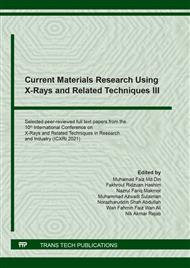p.543
p.549
p.555
p.563
p.570
p.578
p.585
p.592
p.598
Green Synthesis of Nanostructured Zinc Oxide (ZnO) - Titanium Dioxide (TiO2) Thin Films
Abstract:
Zinc Oxide (ZnO) nanostructured was synthesized by green method. The zinc acetate dehydrated, Zn (CH3COO)2.2H2O was mixing with psidium guajava leaves extract as reducing as well as capping agent which is very simple, rapid, cost-effective and environment friendly route. However, Titanium Dioxide (TiO2) sol-gel was synthesized by using titanium (IV) butoxide, Ti (OC4H9)4, butanol, C4H9OH, acetic acid, CH3COOH, and distilled water, H2O. The deposition of ZnO/TiO2 thin films on the glass substrate applied by spin coating method. The calcination temperature has been used for the first layer of ZnO were 400 °C, 500 °C, 600 °C and for the second layers, which is TiO2, were 500 °C and 600 °C. Four types of characterization were perform to analyse the ZnO/TiO2 thin films such as X-ray diffraction (XRD), field emission scanning electron microscope (FESEM), and Atomic Force Microscopy (AFM). From XRD analysis, the result shows the zincite structure of ZnO thin films and the anatase structure of TiO2 thin films. Besides, increasing the calcination temperature will increase the peak intensity. Furthermore, FESEM performed to analyse the surface morphology of ZnO/TiO2 thin films, which is when calcination temperature increase will increase the size of the particles. Meanwhile, the analyzing of ZnO/TiO2 thin film using AFM shows that with increasing the calcination temperature will increase the surface roughness and particle size. The UV-Vis was use to determine the optical properties of the ZnO/TiO2 thin films where it shows the percentage transmittance improved after increase calcination temperature.
Info:
Periodical:
Pages:
570-577
Citation:
Online since:
January 2022
Keywords:
Price:
Сopyright:
© 2022 Trans Tech Publications Ltd. All Rights Reserved
Share:
Citation:


